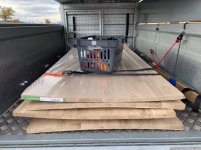FestitaMakool
Member
I got these glued up counter tops in oak, 2000x800x26mm for $30 each.. (The lady at the counter said: That was $435 off for 4 tops.. [big grin]) - See photos below.
Anyway, the price was very right, I figured this can all be used, even if I end up ripping it down and glueing again to a good few projects. But now I’m trying to climate them to get rid of most of the curve..
I didn’t see that in the shop, but look at the end grain, there are two layers, one layer substantially thinner. I figured this is what make up the tension and uneven swelling/drying.
What do you think about it?
[attachimg=1]
Anyway, the price was very right, I figured this can all be used, even if I end up ripping it down and glueing again to a good few projects. But now I’m trying to climate them to get rid of most of the curve..
I didn’t see that in the shop, but look at the end grain, there are two layers, one layer substantially thinner. I figured this is what make up the tension and uneven swelling/drying.
What do you think about it?
[attachimg=1]

